| Penumbral eclipse | |||||||||
| Date | 7 October 1987 | ||||||||
|---|---|---|---|---|---|---|---|---|---|
| Gamma | 1.01890 | ||||||||
| Magnitude | 0.98640 | ||||||||
| Saros cycle | 146 (9 of 72) | ||||||||
| Penumbral | 253 minutes, 33 seconds | ||||||||
| |||||||||
A penumbral lunar eclipse took place on Wednesday, October 7, 1987, the second of two lunar eclipses in 1987, the first being on April 14, 1987. The Moon approached within 0.00949% of its diameter outside of touching the Earth’s umbral shadow at maximum eclipse; 98.63% of the Moon's disc was partially shaded by the Earth, with the overall eclipse lasting 4 hours and 14 minutes. While less dramatic than a partial eclipse (as no part of the Moon was in complete shadow), a shading across the Moon should have been readily visible to observers. The Moon was just 3.1 days after perigee (Perigee on Sunday, October 4, 1987), making it 2.1% larger than average.[1]
Visibility
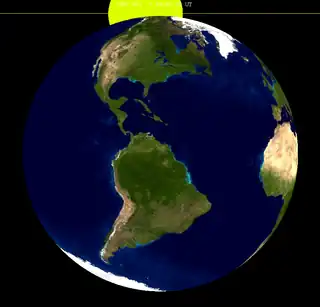
Related lunar eclipses
Eclipses of 1987
- A hybrid solar eclipse on March 29.
- A penumbral lunar eclipse on April 14.
- An annular solar eclipse on September 23.
- A penumbral lunar eclipse on October 7.
Lunar year series
| Lunar eclipse series sets from 1984–1987 | ||||||||
|---|---|---|---|---|---|---|---|---|
| Descending node | Ascending node | |||||||
| Saros | Date Viewing |
Type Chart |
Gamma | Saros | Date Viewing |
Type Chart |
Gamma | |
| 111 | 1984 May 15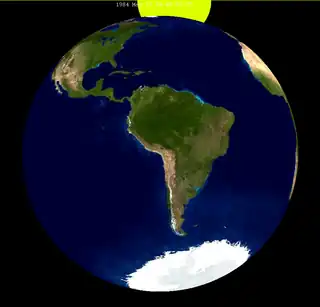 |
Penumbral |
1.11308 | 116 | 1984 Nov 08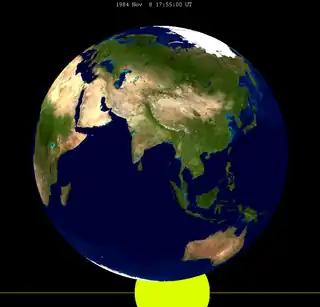 |
Penumbral |
−1.08998 | |
| 121 | 1985 May 04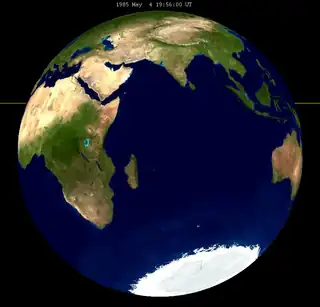 |
Total |
0.35197 | 126 | 1985 Oct 28 |
Total |
−0.40218 | |
| 131 | 1986 Apr 24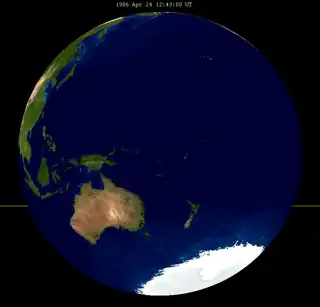 |
Total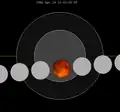 |
−0.36826 | 136 | 1986 Oct 17 |
Total |
0.31887 | |
| 141 | 1987 Apr 14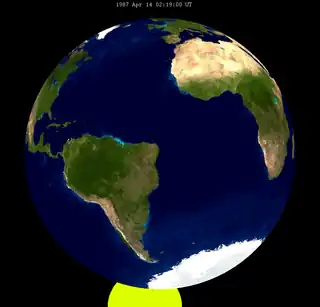 |
Penumbral |
−1.13641 | 146 | 1987 Oct 07 |
Penumbral |
1.01890 | |
| Last set | 1984 Jun 13 | Last set | 1983 Dec 20 | |||||
| Next set | 1988 Mar 03 | Next set | 1988 Aug 27 | |||||
Half-Saros cycle
A lunar eclipse will be preceded and followed by solar eclipses by 9 years and 5.5 days (a half saros).[2] This lunar eclipse is related to two partial solar eclipses of Solar Saros 153.
| October 2, 1978 | October 12, 1996 |
|---|---|
 |
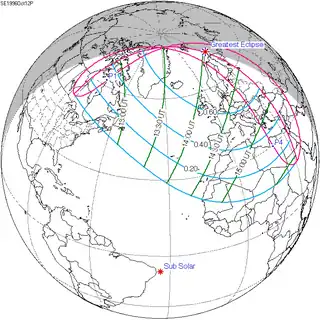 |
See also
Notes
- ↑ Hermit Eclipse: Saros cycle 146
- ↑ Mathematical Astronomy Morsels, Jean Meeus, p.110, Chapter 18, The half-saros
External links
- 1987 Oct 07 chart Eclipse Predictions by Fred Espenak, NASA/GSFC